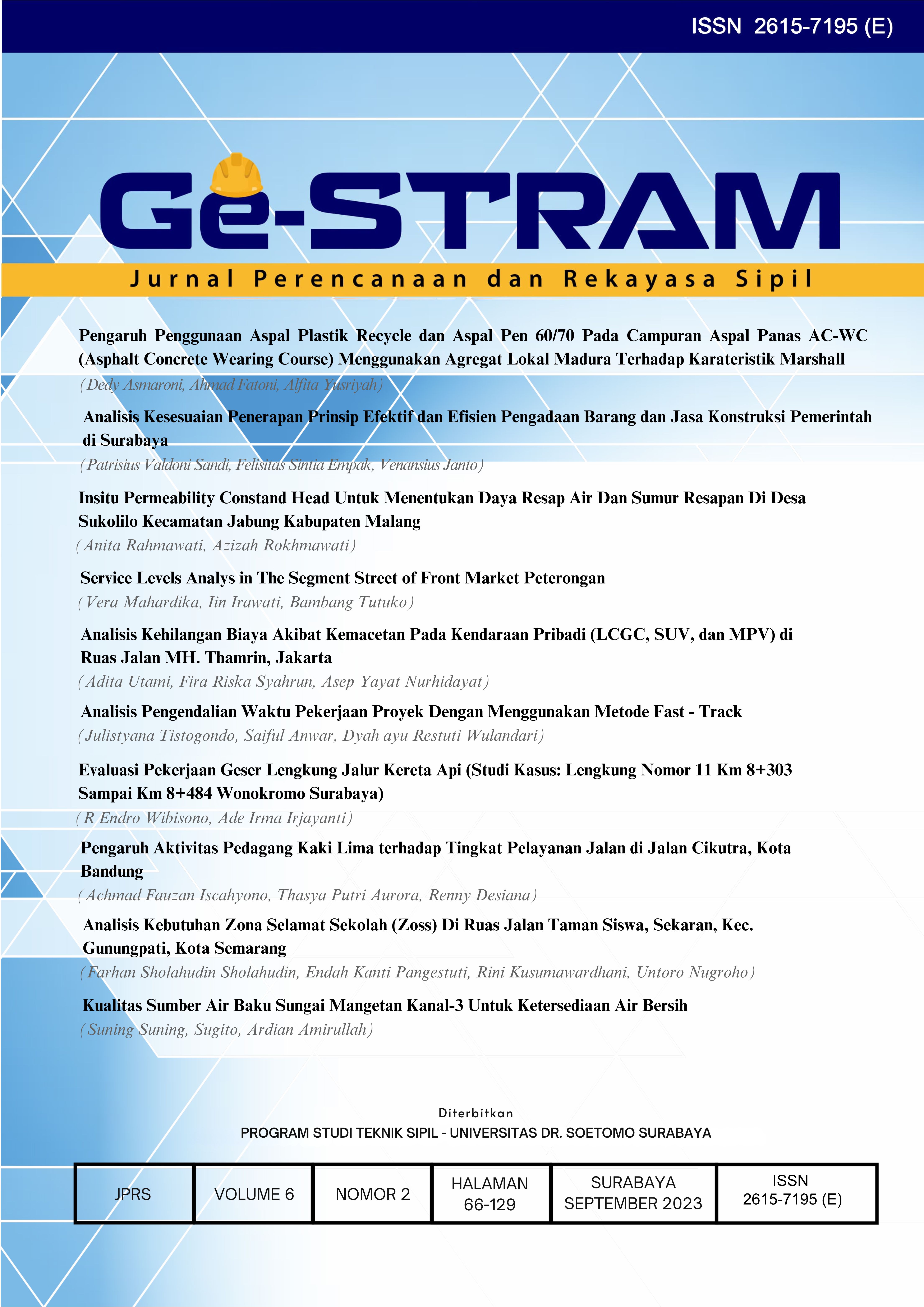Analisis Pengendalian Waktu Pekerjaan Proyek Dengan Menggunakan Metode Fast - Track
 Abstract views: 311
,
Abstract views: 311
,
 PDF downloads: 784
PDF downloads: 784
Abstract
Abstract
Due to poor administrative supervision and a lack of collaboration amongst all interested parties, the Situbondo Paramaan Bridge Replacement project was delayed to the detriment of all stakeholders. In order to comprehend the contributing factors that contribute to the delays, the researcher's objective with this delay issue is to compare the fast track technique and not use it. The replacement project for the Situbondo Paramaan Bridge, which has fallen behind schedule, is the main subject of this study.
The primary and secondary data for this study, which combines qualitative and quantitative research approaches, were processed using Microsoft Project 2016.The data were gathered straight from the project. With a focus on time management, the fast track technique is used to address project delay difficulties.
This study aims to accelerate time so that the project can be finished on schedule or even earlier than the time agreed upon between the contractor and the project owner. The replacement project for the Paramaan Bridge in Kab. Situbondo has been delayed for a number of reasons. to t projects in order to avoid further promake it possible for these factors to be concentrated on completing the solution for subsequenject delays.
References
2. Dipohusodo, 1996. Manajemen Proyek Konstruksi Jilid I. Kanesius. Jakarta.
3. Ervianto, W.I. 2002. Manajemen Proyek Konstruksi (Edisi Revisi). Andi .Yogyakarta.
4. Easthan, G. 2002, “The Fast Track Manual”, European Construction Institute, United Kingdom. dalam
5. Tjaturono dan Indrasurya, B.M. Pengembangan Metode Fast-Track untuk Mereduksi Waktu dan Biaya
6. Pelaksanaan Proyek. (Studi Kasus : Rumah Menengah di Malang, Jawa Timur), Media Komunikasi Teknik Sipil.
7. Fuady, M. 1998. Kontrak Pemborongan Mega Proyek, PT. Citra Aditya Bakti. Bandung.
8. Harris, R. B. and Photios, G. I. 1998a. Scheduling Project with Repeating Activities, Journal of Construction Engineering and Management, Vol. 124 No. 4, July-August, hlm 269-278.
9. Heizer, J. & Barry, R. 2006. Manajemen Operasi Edisi Tujuh. Selemba Empat. Jakarta.
10. Husen, A. 2009. Manajemen Proyek (Edisi II) , Andi. Jakarta.
11. Mardianto, D. 2009. Analisis Pengaruh Metode Fast-Track Pada Penjadwalan Terhadap Biaya Pelaksanaan Proyek Apartemen Parayangan Residences. (Tugas Akhir yang tidak dipublikasikan, Jurusan Teknik Sipil Institut Teknologi Bandung, 2009).
12. Masterman, J. W. E. (1992). An Introduction to Building Procurement Systems.2nd edn. London: E & FN Spon.
13. Mora, F.P. dan Li, M. (2001) Dynamic Planning and Control Methodology for Design/Build Fast Track Construction Enginnering and Management, ASCE, Vol. 127
14. Tjaturono dan Indrasurya, B.M. Pengembangan Metode Fast-Track untuk Mereduksi Waktu dan Biaya Pelaksanaan Proyek. (Studi Kasus : Rumah Menengah di Malang, Jawa Timur), Media Komunikasi Teknik Sipil.
15. Nurhayati. 2010. Manjemen Proyek. Graha Ilmu. Yogyakarta.
16. Prasetya, H. dan Lukiastuti, F. 2009. Manajemen Operasi,Cetakan Pertama. Media Pressindo. Yogyakarta.
17. Soeharto, I 1999. Manajemen Proyek Dari Konseptual Sampai Oprasional. Erlangga Jakarta.
18. Tjaturono. 2004. Penerapan Produktivitas Tenaga Kerja Aktual dan Modifikasi Penjadwalan dengan Metode
19. Fast-Track untuk Mereduksi Waktu dan Biaya Pelaksanaan Proyek. (Studi Kasus : Rumah Menengah di Malang, Jawa Timur), Media Komunikasi Teknik Sipil.
20. Tjaturono. Dan Indrasurya, B.M. 2008. Pengembangan Metode Fast-Track untuk Mereduksi Waktu dan Biaya Pelaksanaan Proyek. (Studi Kasus : Rumah Menengah di Malang, Jawa Timur), Media Komunikasi Teknik Sipil.
21. Tiong, 1996. Comparative Study of BOT Project, ASCE : Journal Management in Engineering vol. 121.
Copyright (c) 2023 Julistyana Tistogondo, Saiful Anwar, Dyah ayu Restuti Wulandari

This work is licensed under a Creative Commons Attribution-ShareAlike 4.0 International License.
Authors who publish with this journal agree to the following terms:
- Authors retain copyright and grant the journal right of first publication with the work simultaneously licensed under a Creative Commons Attribution-ShareAlike 4.0 International License that allows others to share the work with an acknowledgement of the work's authorship and initial publication in this journal.
- Authors are able to enter into separate, additional contractual arrangements for the non-exclusive distribution of the journal's published version of the work (e.g., post it to an institutional repository or publish it in a book), with an acknowledgement of its initial publication in this journal.
- Authors are permitted and encouraged to post their work online (e.g., in institutional repositories or on their website) prior to and during the submission process, as it can lead to productive exchanges, as well as earlier and greater citation of published work (See The Effect of Open Access).

This work is licensed under a Creative Commons Attribution-ShareAlike 4.0 International License.















